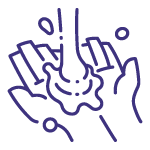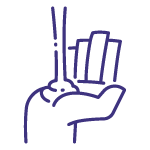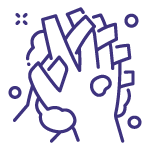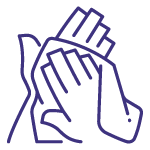Hand Hygiene Education
Infection Prevention and Control
According to nidirect, government services “Washing your hands properly is one of the most important things you can do to help prevent and control the spread of many illnesses. Good hand hygiene will reduce the risk of things like flu, food poisoning, viruses and healthcare associated infections being passed from person to person.”
Hands normally carry lots of germs and should be washed:
- After visiting the toilet
- Before handling food and before eating food
- When visibly dirty
- After cleaning up a child
- After blowing your nose, coughing or sneezing into your hands
- After handling animals
- After travelling on public transport
- After touching a surface that may have been frequently touched by others (handles, shopping baskets, tables, chairs, handrails and intercoms)
- Before and after administering first aid, including treating your own cut or wound
- After handling household waste and recycling
- As soon as you can after shaking hands or hand-to-hand contact with another person
How can you know that your handwashing techniques are really effective in the prevention of the spread of infection?
Good hand hygiene practices have never been more important. Daro UV Systems, an NHS approved and trusted ultraviolet specialist since 1985, has been working with the NHS, care homes, schools and industry to help teach really effective hand hygiene with the help of our Hand Inspection Cabinet.
Understanding you can’t measure what you can’t see, the unit helps you to confidently teach and assess the effectiveness of handwashing techniques
The hand inspection unit is a striking visual and educational aid for users by using harmless UV light, and light responsive UV Indicator Lotion – to highlight areas where handwashing must be improved.
UV Indicator Lotion is applied to the hands, just like hand cream. After washing, when hands are placed in the inspection cabinet any remaining lotion will fluoresce under the ultraviolet lamp, demonstrating flaws in the hand washing technique. By helping members of institutions and organisations identify where they need to improve handwashing technique, more effective infection control can be achieved.
Schools and practitioners of the National Hand Hygiene Campaign have fed back to us “that the unit improved training and children loved it. It is so visual it remains in trainees’ minds for a long time and teaching these skills creates life-long habits.”
Click here for more product information or contact us on 01787 370187 or email info@darouv.co.uk.
Proper Handwashing Technique

1. Start by turning on the water and getting your hands wet. A lot of people reach for soap as the first step, but wetting your hands first produces a better lather for cleaning.

2. Apply soap to your wet hands.

3. Lather up the soap, making sure to spread it up to your wrists, between your fingers, and on your nails and fingertips.

4. Rub your hands together vigorously, palm to palm with interlaced fingers, palm over the back of one hand and then over the other. Pay attention to the back of fingers, thumbs and then your finger tips. Finally clean your wrists using a rotational motion.

5. Rinse your hands well.

6. Dry your hands thoroughly with a clean and dry cloth hand towel.